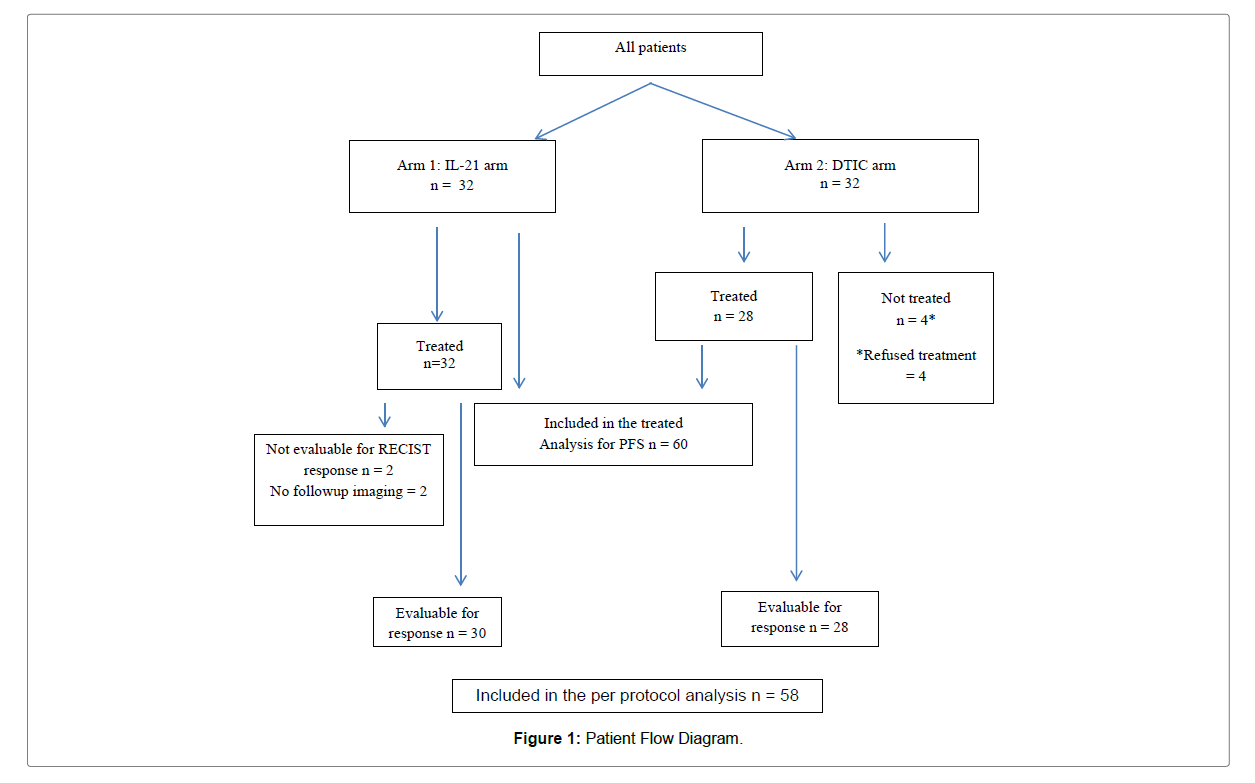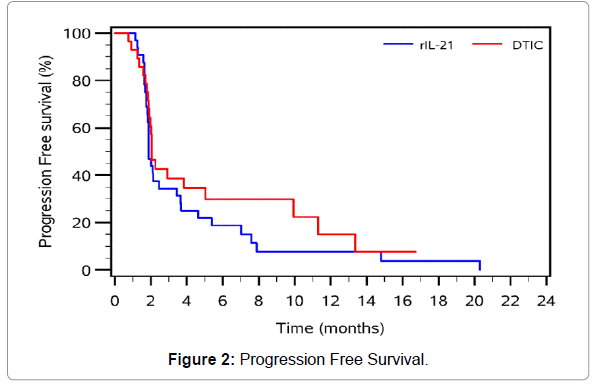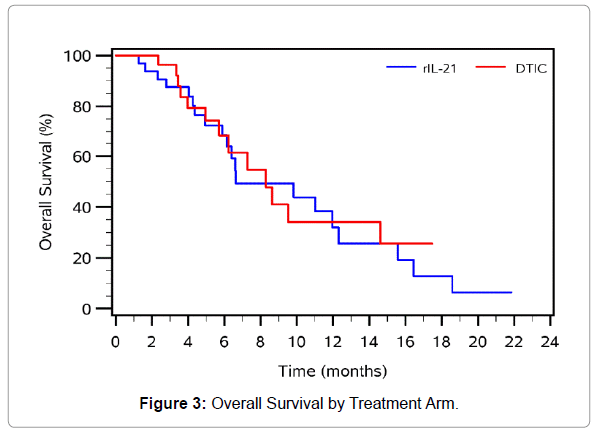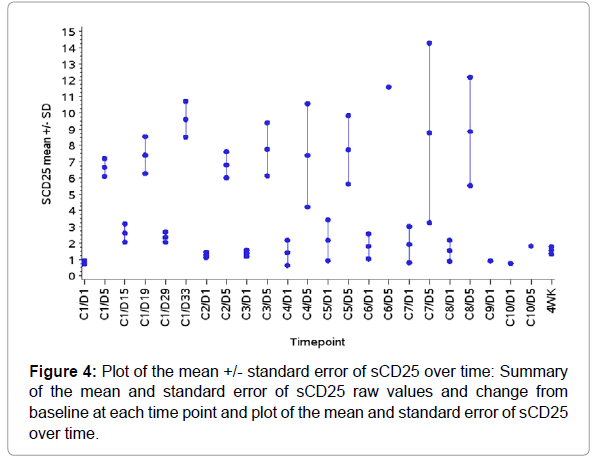Final Efficacy Results of a Randomized Phase II Study of Recombinant Interleukin-21 Compared to Dacarbazine in Patients with Recurrent or Metastatic Melanoma
Received: 30-Jan-2019 / Accepted Date: 06-Feb-2019 / Published Date: 13-Feb-2019
Abstract
Objective: Interleukin-21(IL-21) is a T-cell derived cytokine with antitumour activity dependent on NK cells or CD8+ T cells. A previous phase II study demonstrated an overall response rate (ORR) of 22.5% in previously untreated patients with metastatic melanoma. We conducted a multi-centre randomized phase II study in metastatic melanoma patients to evaluate the efficacy, toxicity, immunogenicity and biomarkers associated with response to IL-21 versus dacarbazine (DTIC).
Methods: Eligible patients: Recurrent, non-resectable or metastatic melanoma patients were treated with either IL-21, 30 μg/kg/day dose intravenous (IV) daily x 5 days, weeks 1, 3, 5, q 8 weeks or dacarbazine (DTIC) 1000 mg/ m2 IV day 1, q 3 weeks. The primary objective was to compare progression free survival (PFS).
Results: 64 patients were randomized, 32 in the IL-21 arm and 32 in the DTIC arm. In the treated population, PFS (1.87 months for IL-21, 2.04 months for DTIC) and ORR {IL-21: 13.3% (95% CI: 3.8 to 30.7), DTIC: 14.3% (95% CI: 4.0 to 32.7)} was similar in both groups. Most common adverse events (AEs) in Arm 1 (IL-21) were nausea (38%), fatigue (56%), fever (34%), maculo-papular rash (34%), and pruritis (38%). In Arm 2 (DTIC) the most common AEs were fatigue (39%), constipation (29%), and nausea (21%). Biomarker studies showed no correlation of sCD25 changes and PFS outcome (HR=0.86, 95% CI. 0.73 to 1.02).
Conclusions: Despite encouraging efficacy in prior phase I/II studies, the results suggest that IL-21 is comparable to DTIC in this specific patient population.
Keywords: Randomized; Phase II; Melanoma; Immunotherapy; Interleukin-21; Dacarbazine; Efficacy; Toxicity
Introduction
Many immunotherapeutic strategies have been developed in the past several decades for the treatment of melanoma. Interleukin-21 (IL- 21) is a T-cell derived cytokine that has been described to play a role in T-cell proliferation, survival and function. It is secreted by CD4+ T-helper cells and promotes the function of effector CD8+ T cells [1,2]. Several studies have shown that its activity involves NK cells and CD8+ T cells through the induction of central and effector memory cells [3,4]. These observations have led to interest in evaluating the activity of IL- 21 in patients with metastatic melanoma.
To date, there have been two single arm phase II studies assessing efficacy for IL-21 in metastatic melanoma. Davis and colleagues showed one confirmed complete response and one partial response among 24 patients (ORR=8.3% 95% confidence intervals, 2.7%-27%) [5]. National Cancer Institute of Canada Clinical Trials Group (NCIC CTG) conducted a single arm open labelled phase II study of IL-21 evaluating the objective response rate (ORR defined by Response Evaluation Criteria in Solid Tumours (RECIST) 1.1), toxicity, Progression Free Survival (PFS) and biomarker profile in patients with metastatic melanoma. Forty patients with no prior systemic therapy, good performance status, no brain metastases and low tumor burden (defined as largest measurable lesion must be ≤ 50 mm in maximum diameter), were treated with IL-21 using 3 different dosing regimens. Of the 39 patients evaluable for response: 9 had a Partial Response (PR) (ORR=22.5%; median duration of response of 5.3 months) 16 had Stable Disease (SD) (median PFS 5.3 months) and 14 had Progressive Disease (PD) with a median PFS of 4.3 months. These promising results from the NCIC CTG trial led to the development of this randomized phase II study comparing IL-21 to Dacarbazine (DTIC).
Patients and Methods
Patients
Eligible patients had histologically confirmed cutaneous metastatic melanoma. Other inclusion criteria included the following: no prior therapy except for BRAF inhibitors, measurable disease by RECIST 1.1, patients must have had either maximum tumour lesion size of ≤ 50 mm or if tumour lesion was >50 mm Lactate Dehydrogenase (LDH) must be ≤ 2.5 x upper limit of normal (ULN), life expectancy 3 months, age ≥ 18 years, Eastern Cooperative Oncology Group (ECOG) Performance Status (PS) of 0 or 1, adequate bone marrow function (absolute granulocytes ≥ 1.5 × 109/L, platelets ≥ 100 × 109/L), serum creatinine ≤1.5 x ULN, bilirubin ≤ ULN, and AST and ALT ≤ 2.5 x ULN. Key exclusion criteria included patients with known HIV, hepatitis B or C infection, uncontrolled intercurrent illness, and known brain metastases. Written consent was obtained from each patient according to local institutional and/or university human experimentation committee requirements of the participating centers.
Study design
This was a multi-centre, randomized phase II study of IL-21 given as a bolus injection (30 μg/kg) daily x 5 in weeks 1, 3 and 5 every 8 weeks (Arm 1) versus DTIC 1,000 mg/m2 by Intravenous (IV) infusion on Day 1 every 3 weeks (Arm 2) for previously untreated or inhibitor failure in BRAF mutated metastatic or unresectable malignant melanoma. The primary objective of the study was to compare PFS of patients treated with IL-21 versus DTIC. The secondary objectives were to compare the effect of IL-21 and DTIC on response rate, duration of response, overall survival, safety and toxicity. Exploratory objectives were to determine the effect of soluble IL2 receptor alpha (sCD25) on response rate, OS, PFS and toxicity outcomes.
Patients were randomized in a 1:1 randomization to either receive IL-21 or DTIC and were stratified by PS 0 versus 1 and gender. All randomized patients were followed till death or for a maximum of 2 years from study entry. Patients in the DTIC arm received institutional standard anti-emetic regimens for highly emetogenic chemotherapy. Patients’ heart rate and blood pressure were monitored before and after each IL-21 infusion and Liver Function Tests (LFTs) were monitored on day 1, 4, 18 and 32 of each cycle of IL-21. Common Terminology Criteria for Adverse Events Version 4.0 (CTCAEv4) was used for toxicity assessment and dose adjustments. Two dose reductions were allowed for toxicity in both arms of the trial.
Computed Tomography (CT) or Magnetic Resonance Imaging (MRI) evaluations for tumour restaging per RECIST were performed every 8 weeks for both arms. Patients with SD or better were eligible to continue on study.
Statistical Considerations
The primary endpoint of this study was PFS, defined as the time from randomization to the time of documented progression event or death by any cause (RECIST 1.1). For subjects that were alive without a progression event at the time of data cut-off for final analysis, PFS was censored on the date of last follow-up. PFS of subjects in both treatment arms was described by the Kaplan-Meier method. A stratified onesided log-rank test adjusting for stratification factors was the primary method to compare PFS between IL-21 and the DTIC arms. As an exploratory analysis, a Cox proportional hazards model was used to identify and adjust for factors significantly related to PFS.
The study sample size was calculated to compare PFS between subjects randomized and treated on Arm 1 versus Arm 2. The historical PFS expected with dacarbazine in the general metastatic melanoma population is 1.7 months. With one-sided alpha of 0.1, 58 progression events are required to provide 80% of power to detect a hazard ratio of 1.75 (Arm 2 versus Arm 1). This hazard ratio was selected based on a multivariate model comparing PFS between NCIC CTG IL-2 phase II and historical NCIC CTG melanoma trial data, adjusted for age, gender, performance status, liver disease and number of disease sites. With an expected accrual rate of 6 to 10 patients per month, a sample size of 80 patients was chosen to allow analysis of PFS approximately 6 months after the last patient is accrued. However the study was closed early due to funding decisions and only 64 patients were accrued.
Correlative Studies
Baseline blood, serum and plasma samples were obtained prior to receiving treatment in this trial from all subjects. Whole blood samples for analysis of somatic DNA were collected at study entry from subjects who consented to participate in pharmacogenetic analyses.
Circulating T lymphocytes and Dendritic Cells (DC) subpopulations were quantified in blood before and after treatment (day 15) as potential biomarkers for drug activity. Specifically, the following sub-populations were assessed by FACS: baseline and post-treatment regulatory T cells (Treg as defined in this study by CD4+FoxP3+ cells), plasmacytoid dendritic cells (pDC), and myeloid Dendritic Cells (mDC).
The pharmacodynamics of IL-21 was assessed by quantifying the serum levels of soluble CD25. Timing of sCD25 samples was predose, Cycle 1, Days 1, 5, 15, 19, 29 and 33; Pre-dose all subsequent cycles and Day 1 and 5. The concentration of sCD25 in each serum sample was quantified using a validated immunoassay. Descriptive summary statistics such as sample size (n), mean, standard deviation (std), median and range (min, max) were used for sCD25 biomarker. Analysis of variance method was used to compare sCD25 values among best response groups. Maximum change of sCD25 was defined as the change from baseline at cycle 1 to cycle 10 and was evaluated from baseline up to cycle 10. As a sensitive analysis, additional analyses were conducted for maximum change that was based on cycle 1 data.
Results
Patient disposition
This study was conducted at 13 centers across Canada and one center in the United States from June 28, 2010 to February 29, 2012. A total of 64 patients were enrolled and randomized to this study (Arm 1 IL-21, n=32; Arm 2 DTIC n=32). Sixty patients received at least one dose of study treatment (Arm 1, n=32; Arm 2, n=28). Four patients randomized to DTIC did not receive treatment due to patient refusal post randomization. At time of analysis, 32 patients had discontinued therapy in Arm 1: 27 for progressive disease, 1 death, 3 for adverse events and 1 patient refusal. In Arm 2, twenty six patients discontinued treatment: 19 with progressive disease, 4 patient choices, 2 for symptomatic progression and 1 physician choice (Figure 1).
Patient demographics and clinical characteristics
Baseline demographics and clinical characteristics were well balanced between the two treatment arms (Table 1). For the treated population, the median age was 62.1 years old (range: 28.5 to 93.7). There were no patients that received prior treatment with BRAF and MEK inhibitors. The majority of the enrolled patients had M1c disease (Arm 1, Arm 2) (Table 1).
| Characteristic | Arm 1 | Arm 2 |
|---|---|---|
| IL-21 | Dacarbazine | |
| N (%) | N (%) | |
| No. enrolled | 32 | 32 |
| No. Treated | 32 | 28 |
| No. evaluable | ||
| Response | 30 | 28 |
| Toxicity | 32 | 27 |
| Age, years | ||
| Median | 60 | 65 |
| Range | 29 - 94 | 31 - 81 |
| Gender | ||
| Female | 9 (28-1%) | 6 (21.4%) |
| Male | 23 (71.9%) | 22 (78.6%) |
| ECOG PS | ||
| 0 | 21 (65.6%) | 19 (67.9%) |
| 1 | 11 (34.4%) | 9 (32.1%) |
| Prior BRAFi therapy | 0 | 0 |
| No. of disease sites | ||
| 1 | 5 (15.6%) | 5 (17.9%) |
| 2 | 8 (25.0%) | 7 (25.0%) |
| 3 | 11 (34.4%) | 11 (39.3%) |
| 4 | 2 (6.3%) | 3 (10.7%) |
| > 5 | 6 (18.8%) | 2 (7.1%) |
Abbreviations: No: Number; ECOG PS: Eastern Cooperative Oncology Group Performance Status.
Table 1: Patient Demographics and Baseline Characteristics
Primary efficacy endpoint
The median PFS was 1.87 months (95% C.I. 1.74 to 3.45) for patients on the IL-21 arm, while it was 2.04 months (95% C.I. 1.87 to 5.03) for patients on the DTIC arm (Figure 2). The 6 month PFS rate was 19% (95% C.I. 8% to 34%) for patients on the IL-21 arm and 30% (95% C.I. 14% to 48%) for patients on the DTIC arm. The Hazard Ratio (HR) was 1.10 (IL-21 versus DTIC, 95% C.I. 0.60 to 2.01) with a stratified log rank test p-value of 0.76.
Secondary efficacy endpoints
Patients were evaluable for response if they received at least one dose of protocol therapy and had at least one tumour assessment. The ORR for the IL-21 arm was 13.3% (95% CI: 3.8 to 30.7) and 14.3% (95% CI: 4.0 to 32.7) for the DTIC arm with a stratified Cochran–Mantel- Haenszel test p value of 0.91 for the treated population (Table 2). None of the pre-specified factors (age, gender, ECOG PS, lesion site, number of sites and LDH) were significantly associated with overall response rate. The median duration of response for the 4 patients with PRs on the IL-21 arm was 5.2 months (95% CI: 0.5 to 13.1) and had not been reached for the 4 patients with PRs on the DTIC arm at time of analysis.
| Number of Patients (%) | ||
|---|---|---|
| Response | IL-21 N=30 | Dacarbazine N=28 |
| Complete Response (CR) | 0 (0) | 0(0) |
| Partial Response (PR) | 4 (13.3) | 4 (14.3) |
| Stable Disease (SD) | 9 (30.0) | 8 (28.6) |
| Progressive Disease (PD) | 17 (56.7) | 16 (57.1) |
Table 2: Treatment Response (based on treated population)
The median OS was 6.64 months (95% C.I. 5.88 to 12.32) for patients on the IL-21 arm, while it was 7.29 months (95% C.I. 4.96 to infinity) for patients on the DTIC arm. The 12 month OS rate was 32% (95% C.I. 13% to 52%) for patients on the IL-21 arm and 35% for the patients on the DTIC arm (95% C.I 14% to 58%). The HR was 0.80 (IL-21 versus DTIC, 95% C.I. 0.38 to 1.68) with a stratified log rank test p-value of 0.55 (Figure 3).
Safety and toxicity
Overall DTIC was well tolerated. The most common treatment related AEs were fatigue (39%), constipation (29%), and nausea (21%). The most common treatment related AEs in Arm 1 (IL-21) were nausea (38%), fatigue (56%), fever (34%), chills (22%), maculo-papular rash (34%), and pruritis (38%). Four patients that received IL-21 experienced serious adverse events: acute hepatic failure and acute kidney injury resulting in death in one patient, an infusion-related reaction, autoimmune disorder and elevated AST and ALT. Three patients in the IL-21 arm and 4 patients in the DTIC arm required dose reductions due to toxicity.
Correlative studies
Soluble IL2 receptor alpha (sCD25) has been shown to increase with treatment of IL-21. Patients receiving IL-21 had low sCD25 values at day 1 of each cycle and sCD25 increased at day 5 in cycles 1, 2, 3, 4, 5, 7 and 8 (Figure 4). There were no data for cycle 6, 9, and 10 (Figure 4). Exploratory analysis of PFS with sCD25 as a continuous covariate showed that baseline sCD25 was not associated with PFS outcome (p=0.44). There was a trending association between maximum change sCD25 and PFS outcome (HR=0.86, 95% CI. 0.73 to 1.02, p=0.08). However, a maximum change from baseline was significantly associated with both PFS (p=0.04) and OS (p=0.02).
No significant correlation with PFS was observed for Treg nor pDC counts. However, overall DC absolute change (p=0.03) and the mDC absolute change (p=0.02) were associated with PFS outcome.
Discussion
This is the first randomized phase II study that has compared IL- 21 to DTIC in treatment naïve metastatic melanoma patients. The primary objective of this study was PFS, with secondary objectives of ORR, OS and biomarker changes. No difference was seen between the 2 arms with 1.87 month and 2.04 month PFS in the IL-21 and DTIC arms respectively. There was also no difference in ORR and OS in this study. In the previous NCIC CTG IL-21 phase II study, an ORR of 22.5% with a median duration of response 5.3 months was seen [6]. The response rate for IL-21 is lower in this randomized trial than our previous phase II trial, however it is similar to what has been reported in other phase I/II trials [5,7,8]. Other randomized trials have also reported similar efficacy with DTIC [9].
Generally the DTIC was better tolerated with the most common AES being fatigue, constipation, and nausea. In the IL-21 arm the most common side-effects were flu-like symptoms and rash, however 4 patients experienced a serious adverse event (12.5%) with one resulting in death. No new safety concerns were seen in this trial compared to prior studies. IL-21 toxicity profile appears to be less severe and a different spectrum than the toxicity seen with IL-2 and is comparable to serious events seen with ipilimumab and the anti- programmed cell death protein 1 drugs.
Soluble IL-2 receptor (sCD25) is cleaved from T and NK cells on activation and was measured as a marker of immune activation following IL-21 administration. We observed an association with a maximum change from baseline with both PFS and OS. As this was an exploratory analysis, it would need further study in subsequent trials. A biomarker of immunotherapy whether for IL-21 or other immunotherapies is needed to better select patients who respond, especially given the toxicities associated with immunotherapies.
No differences in Tregs or pDC counts were associated with PFS. However a significant correlation with clinical response was observed for mDCs. This suggests that the benefit of IL-21involves DC maturation and components of the innate immunity, and therefore involves a different mechanism than checkpoint inhibition. This is of importance in the context of putative synergy between IL-21 and checkpoint inhibitors. Combined treatment with IL-21 and anti- PD-1 enhanced the antitumour immune response compared with that induced by IL-21 alone in murine models [10]. A recent study using mouse tumour models, showed that treating mice with a combination of recombinant IL-21 and mouse CTLA-4 monoclonal antibodies or anti-PD-1 enhanced efficacy in 2 out of 4 tumour types in contrast to monotherapy [11].
Conclusion
In conclusion, this trial has shown that IL-21 is comparable to DTIC in this patient population with possibly more toxicity. Treatment of metastatic melanoma has improved over the last several years with the advent of better therapies. Given the low response rates and higher toxicity that were seen in this trial, as well as evidence for synergy of IL- 21 with checkpoint inhibitors in murine models, IL-21 may be better studied in combination with other therapies, specifically checkpoint inhibitors.
Acknowledgements
We would like to acknowledge CIRION for their laboratory work in sCD25 and serum Immuno-phenotyping.
Funding
p>This work was supported by the Canadian Cancer Society via a core grant to the NCIC Clinical Trials Group and also in part by ZymoGenetics, Inc. and Bristol- Myers Squibb (BMS).
References
- Petrella TM, Mihalcioiu C, McWhirter E, Belanger K, Savage KJ, et al. (2013) Final efficacy results of NCIC CTG IND. 202: A randomized phase II study of recombinant interleukin-21 (rIL21) in patients with recurrent or metastatic melanoma (MM). J Clin Oncol 31.
- Frederiksen KS, Lundsgaard D, Freeman JA, Steven DH, Thomas LH, et al. (2008) IL-21 induces in vivo immune activation of NK cells and CD8(+) T cells in patients with metastatic melanoma and renal cell carcinoma. Cancer Immunol Immunother 57: 1439-49.
- Parrish-Novak J, Dillon SR, Nelson A, Hammond A, Sprecher C, et al. (2000) Interleukin 21 and its receptor are involved in NK cell expansion and regulation of lymphocyte function. Nature 408: 57-63.
- di Carlo E, de Totero D, Piazza T, Fabbi M, Ferrini S (2007)Â Role of IL-21 in immune-regulation and tumor immunotherapy. Cancer Immunol Immunother 56:1323-34.
- Davis ID, Brady B, Kefford RF, Millward M, Cebon J, et al. (2009) Clinical and biological efficacy of recombinant human interleukin-21 in patients with stage IV malignant melanoma without prior treatment: a phase IIa trial. Clin Cancer Res 15: 2123-9 .
- Petrella TM, Tozer R, Belanger K, Savage KJ, Wong R, et al. (2012) Interleukin-21 Has Activity in Patients With metastatic Melanoma: A Phase II Study. J Clin Oncol 30: 3396 -401.
- Davis ID, Skrumsager BK, Cebon J, Nicholaou T, Barlow JW, et al. (2007) An open-label, two-arm, phase I trial of recombinant human interleukin-21 in patients with metastatic melanoma. Clin Cancer Res 13: 3630-6.
- Thompson JA, Curti BD, Redman BG, Bhatia S, Weber JS, et al. (2008) Phase I study of recombinant interleukin-21 in patients with metastatic melanoma and renal cell carcinoma. J Clin Oncol 26: 2034-9.
- Robert C, Long GV, Brady B, Caroline D, Michele M, et al. (2015) Nivolumab in previously untreated melanoma without BRAF mutation. N Engl J Med 372: 320-30.
- Pan XC, Li L, Mao JJ, Yao W, Zheng JN, et al. (2013) Synergistic effects of soluble PD-1 and IL-21 on antitumor immunity against H22 murine hepatocellular carcinoma. Oncol Lett 5: 90-96.
- Lewis KE, Selby MJ, Masters G, Valle J, Dito G, et al. (2017) Interleukin-21 combined with PD-1 or CTLA-4 blockade enhances antitumour immunity in mouse tumour models. Oncoimmunology 7:e1377873.
Citation: Petrella TM, Mihalcioiu C, Monzon J, McWhirter E, Belanger K, et al. (2019) Final Efficacy Results of a Randomized Phase II Study of Recombinant Interleukin-21 Compared to Dacarbazine in Patients with Recurrent or Metastatic Melanoma. J Oncol Res Treat 4: 132.
Copyright: © 2019 Petrella TM, et al. This is an open-access article distributed under the terms of the Creative Commons Attribution License, which permits unrestricted use, distribution, and reproduction in any medium, provided the original author and source are credited.
Select your language of interest to view the total content in your interested language
Share This Article
Open Access Journals
Article Usage
- Total views: 4580
- [From(publication date): 0-2019 - Dec 17, 2025]
- Breakdown by view type
- HTML page views: 3615
- PDF downloads: 965




